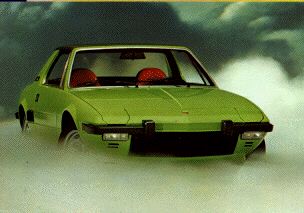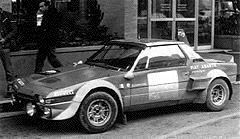I think the story about how the Fiat X1/9 became the car it is, is maybe one of the most fascinating stories in the car history. Still all the finer details in the story is not yet discovered, so some of this story must be qualified guessings. As new books are launched, new aspects are reveled for us.
My story begins in the late sixties at Bertone where the chief designer Marcello Gandini and his chief Nuccio Bertone had just finished the mid engined Lamborghini Miura. This was Mr. Gandini's first design at Bertone. But at the Bertone factory there was another big success in production: The Fiat 850 Sport Spider.
The people at Bertone knew that Fiat was developing their first frontwheel drive cars, because Fiat had already tried the concept in the Autobianchi Primula. So even if the little 850 Spider (designed by Bertone's former chief designer Giugiaro) was a good seller, they could already foresee that a new car would take it's place in the near future.
Then there would be two scenarios: Either a softtop frontwheel drive car that could be produced at Fiat as a Fiat 128 Spider. Or a special low volume (for Fiat) new sport spider that could only be produced at a smaller factory, ex. at Bertone.
So Bertone took the drive unit from the Autobianchi Primula, added the nearly finished new engine from the 128, and built a wild and beautiful open barchetta, and they called the prototype Autobianchi A112 Runabout. This car was showed at the 1969 Torino Car Exhibition. At he same time as the Fiat X1/1 (the Fiat 128) debuted. The runabout was clearly a good idea, so Fiat decided to go ahead with the project together with Bertone. In 1972, a week after the Torino Show (because Fiat 131 debuted at the show...), the new Fiat X1/9 debuted. The internal code became the new car's name because this "128 Spider" did not have frontwheel drive as the rest of the 128 lineup.

23rd of November 1972 was the debute date,and the start date for the production of the X1/9. Although at a fairly high price (as much as a Volvo 144), the little, but real midengined sportscar was a uge success. The motoring press loved the new car, many jounalists was driving sideways in the corners just for the fun of it! Autocar's Peter Windsor (UK) summed up his first 12,000 miles in just three words: "A baby Ferrari".
So the X1/1 became the frontwheel drive 128 in 1969. The X1/4 became the 903 ccm 127 (same driveline as X1/2, the Autobianchi A112, and same engine as in the 850 sport spider) in 1971. X1/3 became the big 130. The midship twincam engined X1/8 was at first stopped, but became later the X1/20 which debuted as the Lancia Montecarlo in 1975. Both the X1/8 and the X1/9 was technically heavy influenced of the midengined prototype Fiat G.31 back in 1966. I have also seen the story that X1/30 became the later Fiat 138, which we know as the Ritmo (Strada in some countries). I don't know if Fiat still call new projects "X1/something"...
The X1/9 is exstreme stiff to be a open top car. The background for this stiffness is a separat story. At the late sixties the the americans was planning new safety regulations in the USA. One goal was new crash tests that should be the same for all cars, even the open top cars. So Bertone made the car stiff as hell with a roll over cage. The result was very good. Together with Volvo the little Fiat was the only one to make it through the new test like frontal crash from 70 km/h and roll over from 120 km/h without much less room in the cabin. Then the americans discovered that non of thir own USA-cars did it through the tests, so they lowered the levels of these tests...
The result of all this stiffness is that the X1/9 is quite heavy to be a small sports car of the early seventies. However the stiffness and the dynamics allow for bigger engines. The first one to make a racing car of the X1/9 was Fiat's inhouse tuning expert Abarth. In 1973 he fitted the 1840 ccm twincam 124-engine in his Abath Prototipo 2000. After Abarth's tune up this engine developed about 200 bhp! And the car was just 750 kg! This could be Fiat's new rally car, if Fiat didn't decide to make the shorter Lancia Stratos (also with design by Bertone & Gandini) for this task...

Dallara (the constructor of several Ferrari and Lamborghini engines) did the Dallara Icsunonove race car the same year. From the standard 1300 unit he developed a 1600 with his own 16 valve head. It gave 200 bhp at 10,000 rpm. And the car was just 650 kg. Terrific! "Ics-uno-nove" means "x-one-nine" in Italian of course...
The Fiat X1/9 started as the 1300 at the end of 1973. The cars looked like the green car at the top of this page. Even the light green colour was typical of these first years. The cars' bodywork and interior was finished at the Bertone factory, and then transported to Fiat. Then the mechanical parts and engines was mounted there.
The first minor facelift came in 1976 with the grille at the lower part of the rear end. The US model got the twin-bar bumpers. In 1977 the cars got the laddes stripes and a new black front spoiler. The engine was still the 1300 unit. With 75 bhp in Europe and 66 bhp in the US catalyst converter units. The Lido model was made specially for the introduction of the X1/9 in Great Britain. They were black with chrome bumpers. Very nice indeed!
The largest change to the X1/9 came in late 1978. The car got the 85 bhp1500 Ritmo/Strada unit (75 bhp in the US) and the 5 speed gearbox. At the same time the bumpers was changed to a new US bumper type. The european cars got the same bumpers as the US models (actually the main aluminium profiles in these bumper was made at Raufoss Aluminium in Norway. The rumours say that there is still a lot of these parts there!). The engine lid became higher and wider (the 1500 unit is actually a 1300 with longer strokes, you can actually change the tops on the early 1500 to 1300 tops and get a little higher compression!). And the interior got new seats and a new dashboard.

In 1982 the car changed name to Bertone X1/9 (actually Fiat wanted to stop the pruduction, but Bertone wanted to continue). Now the engines and other mechanical parts was delivered to the Bertone factory which mounted the whole cars. Until the end of production in 1989 (sough!) the car went through several minor changes. The easiest way to recognise a Bertone X1/9 is the two-colour paintjob and leather seats. The photo above shows a good UK example of a Bertone car. The car is a european spec cars, spotted only by the small round indicators just ahead of the front wheels. An US model would have larger rectangular side-lights at the same place. Some Bertone cars got all-black bumper (painted aluminium).
All in all the pruduction numbers counted about 200 000 cars. About 150 000 of them were Fiat X1/9. The rest were Bertone X1/9. How many of them is still going strong? Nobody knows, but I got the impression that most of these "baby Ferraris" are still alive. More or less...
Read more about the X1/9 in the following books:
...and of course you can find something about the X1/9 in any book about Bertone!